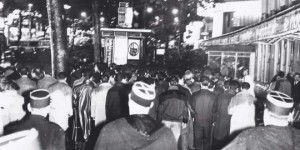Duecento morti, algerini assassinati a Parigi dalla polizia nel 1961. Gettati nella Senna il 17 ottobre del ’61, dagli agenti del prefetto Papon, nel corso di una manifestazione indipendentista indetta dall’Fnl. Un documentario in Francia risolleva il problema di questa strage nascosta, è “Octobre à Paris” di Jacquel Panijel (un’immagine del film nella foto). L’algerina Yasmina Adi ha realizzato invcece “Ici  on noie les Algériens”. Qui di seguito un articolo del Guardian del 18.10.2011:
on noie les Algériens”. Qui di seguito un articolo del Guardian del 18.10.2011:
The massacre that Paris denied
No one was ever brought to justice for the murder half a century ago of up to 200 French-Algerians
guardian.co.uk, Sunday 16 October 2011 20.30 BST
Republican values of liberté, egalité, fraternité will be all but forgotten when thousands of Parisians recall the most murderous episode in the French capital’s postwar history tomorrow. Commemorations are planned for the 50th anniversary of the French-Algerian massacre, when up to 200 peaceful protesters were slaughtered in cold blood around iconic national monuments, including the Eiffel Tower and Notre Dame Cathedral.
The most memorable – and vicious – atrocities saw policemen herding panicking crowds on to Paris’s bridges, where many were tossed into the Seine. Normally a romantic symbol of the most popular tourist city in the world, the river became a watery morgue for scores of victims, whose lifeless bodies were washing up for weeks afterwards.
Others died in police stations, or in nearby woods, where their mutilated bodies testified to truncheon and rifle-butt injuries. The officers had been incensed by an illegal protest by 30,000 men, women and children organised by the National Liberation Front (FLN) – the main Algerian nationalist group in their country’s war of independence with France.
Fifty years will seem like a long time to many of the young French Algerians who mark the anniversary today, but in many ways it seems very recent. Maurice Papon, the Paris police chief who instigated the killings, only died four years ago, aged 96; and some of his unrepentant and unpunished henchmen still remain at large.
Like Papon, many of the killers had been Nazi collaborators who learned their crowd control methods from the Gestapo. They were experts at disinformation too: the official death toll after Papon’s self-proclaimed “Battle of Paris” was initially three, before being revised to a vague “several dozen” almost 40 years later.
No judicial inquiry ever took place, with many French still blaming Algerian in-fighting and terrorist attacks for the deaths. Papon was finally brought to justice for crimes against humanity – but only for those he committed during the second world war. President Charles de Gaulle, and then successive governments, ensured he was never indicted for what he did to the French Algerians of Paris.
Most now live in the blighted housing estates which dot the outskirts of the capital. These banlieues grew out of the immigrant worker shanty towns which became recruiting grounds for the FLN in the 50s and 60s. Police felt they could control “insurgents” better on the estates, and they are still overflowing with young people from north Africa.
As during the nationalist war, French Algerians are still encouraged to stay out of tourist Paris. Curfews are regularly imposed on the estates, with armoured vehicles filled with paramilitaries moving in during disturbances. When particularly heavy rioting broke out in 2005, the then interior minister, Nicolas Sarkozy, imposed a state of emergency. Like the curfews, it was based on Algerian war legislation from 1955.
Up to 40% of young French Algerians from the estates are currently unemployed. Without money or prospects, some have turned to crime, helping to swell a prison population estimated to be up to 70% Muslim. Many resemble the angst-ridden, alienated young Algerians who took to the streets in 1961.
Statistics about the current generation are unofficial because secular France does not record the ethnicity and religion of its citizens, but there is no doubt that French Algerians still regularly experience what it is like to be a second-class citizen. Racism against France’s largest minority group is endemic – from the public and private institutions who fail to employ them, through to the media organisations which fail to report their issues.
Few would argue that the tribal murders committed by Paris police half a century ago are likely to be repeated today. But nor would anyone pretend that the discriminatory policies which gave rise to such horrors have disappeared from modern France.

